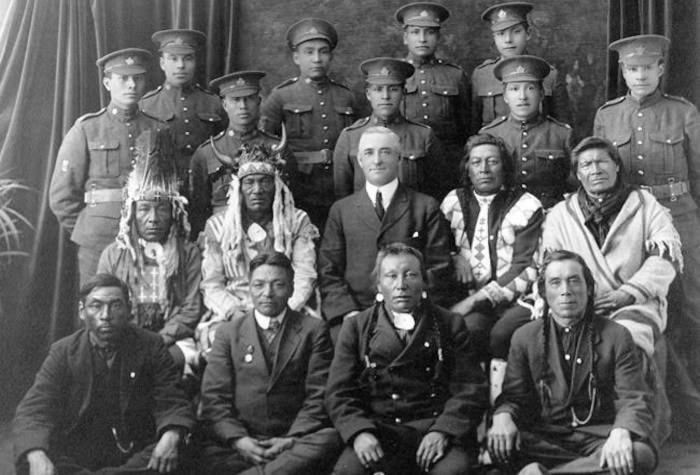Francis Pegahmagabow went to a recruitment office almost immediately after war was declared in 1914.
The Ojibwa sniper from Wasauksing First Nation of Parry Island would serve with the 1st Infantry Battalion and went on to become one of the most decorated soldiers in the First World War.
When he returned to Canada, his reputation as a brave soldier counted for very little and he didn’t receive the same rights or benefits as his white comrades.
“They’d gone from being a soldier to just an Indian again,” said Scott Sheffield, associate professor at the University of Fraser Valley and author of a report on First Nations veterans that prompted a federal government apology in 2003.
Indigenous people were part of every 20th-century conflict Canada was involved in and served in the Canadian military at a higher per-capita rate than any other group.
About 4,000 First Nations men served in the First World War. After the armistice of Nov. 11, 1918, they returned to Canada still unable to vote and largely shut out of the meagre benefits on offer.
Although veterans were eligible to borrow money through the government for farm land, it was almost impossible for First Nations veterans to qualify.
“Worse than that, around 80,000 acres of reserve land that was good for farming was actually taken away from reserves, mostly in the Prairies, and largely given to white settler veterans,” Sheffield said.
That didn’t stop Indigenous people from taking up the call again when Canada joined the Second World War — about 4,300 enlisted.
Thomas (Tommy) Prince, a member of the Brokenhead Ojibwa Nation in Manitoba, enlisted in 1940 and eventually was assigned to the Canadian-American First Special Service Force, known as the Devil’s Brigade. He became a legendary sniper, was awarded multiple medals and also served in the Korean War.
Back in Canada, Prince ended up living in shelters and on the streets of Winnipeg until his death in 1977.
After the Second World War, Indigenous veterans couldn’t get information from trained veterans affairs counsellors, and had to go through their Indian agent. It was difficult for them to connect with non-Indigenous comrades because they weren’t allowed in legion halls.
They were also unable to get a loan-grant combination that helped veterans set up careers and businesses.
But Indigenous men and women continued to enlist and serve in the military — from NATO duties during the Cold War to more recent tours in Afghanistan.
Now an effort is underway to honour their sacrifice.
Randi Gage, a Saginaw Chippewa from Michigan and a United States army veteran, organized the first Aboriginal Veterans Day in Manitoba in 1993. She wanted a day to honour them in their own communities but still allowed them to gather for Remembrance Day ceremonies.
Nov. 8 was chosen because the number turned sideways is the Metis infinity symbol and it’s connected to some First Nations teachings, Gage said. She wrote letters to communities and veterans organizations to spread the word about the event.
“Most of the letters came back the most racist, disgusting: ‘What the hell do you think you are doing?’, ‘What makes you so special?’” she said.
But the event went ahead with a handful of veterans.
The next year, National Aboriginal Veterans Day was inaugurated by Winnipeg’s city council. Gage said thousands of people attended to honour Indigenous veterans.
“To see the pride in those guys, it still gets me today,” she said, starting to cry. “It started the discussion. It started people talking.”
The 25th Aboriginal Veterans Day is being celebrated Thursday but Gage said there is still more work to do.
The federal Standing Committee on Veterans Affairs has launched a study of benefits for Indigenous veterans.
Veterans Affairs said in an emailed statement it is committed meeting the needs of Indigenous veterans and is talking to Aboriginal groups to determine the way forward.
Meanwhile, the Canadian War Museum in Ottawa is holding a photographic exhibition, presented by the Embassy of Belgium, to celebrate the diversity of those who fought for the Allied effort. It includes images of Maori soldiers from New Zealand, Sikhs from the Indian Army Corps, and a photo of Indigenous recruits and elders from File Hills, Sask.
A photo of Inuk sniper John Shiwak, who died on the battlefield in 1917, also hangs on the wall.
Peter MacLeod, the museum’s director of research, said he hopes it changes the perspective of people who fought in the First World War.
“There is a huge story there about the diversity of the Canadian corps and the war effort in general,” he said. “This exhibition … makes Canadians a bit more aware of the diversity in our country’s history and the contribution that all groups have made to Canada.”
The Canadian Press
